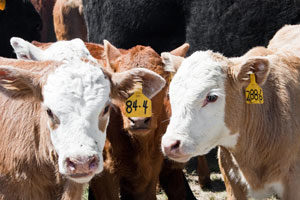The most popular stories varied from production tips and profiles to blog entries and animal welfare tip sheets.
The first year totals showed over 28,619 visitors at the progressivecattle.com site, with 89,134 pageviews.
Looking back on 2011, here were the 11 most popular stories among our readers online, with some updates from authors, sources and contributors.
1. Predictions to watch for in 2011 cattle markets
http://bit.ly/tVomlz
This January piece by University of Nebraska economics professor Darrell R. Mark gave producers a roadmap to 2011, spelling out trends in production, industry supply and cattle marketings.
Top 10 industry predictions included heavier carcass weights, value-based marketings, animal welfare concerns, increased cattle hedging, growing poultry production, high cattle prices, export growth, GIPSA rules, high and volatile feed prices and, topping the list, structural changes from a declining national herd.
“For 12 of the last 14 years, cattle numbers have decreased year over year, culminating in the smallest national herd in the past 60 years. While that hasn’t resulted in a significant decline in commercial beef production due to higher carcass weights and adoption of other technologies, this trend will have a profound long-run impact on the structure of the cattle industry itself.”
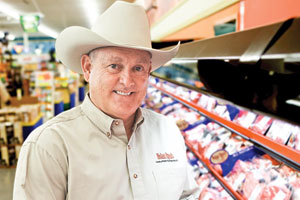 2. Creating Nolan Ryan’s Guaranteed Tender Beef
2. Creating Nolan Ryan’s Guaranteed Tender Beef
http://bit.ly/tIKAtI
While most of America knows Nolan Ryan as a baseball Hall of Famer and as the owner of the Texas Rangers, readers became acquainted with Nolan Ryan’s Guaranteed Tender Beef, a rising niche beef product enjoying widespread success behind the support of Ryan and Beefmaster Cattlemen.
Charlie Bradbury of Beefmaster Cattlemen shared with writer Cassie Payne some of the history, research, marketing and salesmanship that went into building the Nolan Ryan Guaranteed Tender Beef products.
“It’s really just focusing on a good product with a disciplined approach,” Bradbury said of the brand’s success story. “Instead of chasing after one fad or another, [we’re] just trying to do the same thing very well.”
What suggestion can you give to producers out there on how best to capitalize on market conditions and high beef prices going into 2012?
High beef prices create opportunities as well as risks for beef producers. Consumers are still in a recovery mode, carefully watching their household budgets and looking for bargains.
Chicken and turkey will be much lower priced per unit of volume than beef, so consumers will reduce their beef consumption even further.
In the long run that is not a good thing for beef producers. Beef producers looking to remain viable for the long term must find ways to increase herd size.
Certainly the drought in the Southwest has made that more difficult, but it has also created opportunities for solvent and serious producers to grow their leased land inventory as older and discouraged producers (or land owners with sudden windfalls in royalty incomes) look to exit the business.
We know it will rain someday; now is the time to be positioning programs so that when the rains come you can produce and sell more calves.
We have seen a paradigm shift in our value equations. Notions of calf values and production costs from even five years ago just don’t apply today.
Likewise, grading technology in plants and coming improvements in tenderness technology will drive more separation in value for better quality beef (not just more marbling).
The short answer: build your herd numbers!
—Charlie Bradbury, CEO for Beefmaster Cattlemen
PHOTO: Photo courtesy of Nolan Ryan All-Natural Beef.
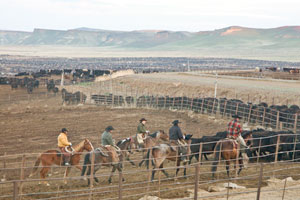 3. The unsung heroes: Pen riders at Simplot feedyard
3. The unsung heroes: Pen riders at Simplot feedyard
http://bit.ly/w4tV86
The June issue on horse management visited one of America’s largest feedyards and followed the pen riders at Simplot Livestock Co. This engaging piece from writer Kim Holt captured life on horseback for cattle manager Shawna Mahon and her 17-member crew.
Days start early at Simplot, with riders heading out at 7 a.m. (earlier in summer) to check some 600 pens before lunch. The day includes moving market-ready cattle and other animals to processing and locating sick cattle to be treated at eight different hospital areas.
Working with horses is a way of life for this crew and, because of their longevity with horses and cattle, a way of pride.
PHOTO: Simplot pen riders on an early morning departure to check cattle. Photo by Kim Holt.
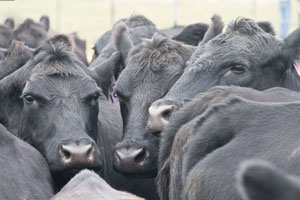 4. Properly sizing up today’s beef cattle
4. Properly sizing up today’s beef cattle
http://bit.ly/tBCwyM
In 1975, the average carcass weight for a heifer was 556 pounds. By 1995 that average had jumped to 750 pounds, with an average increase of about 6.5 pounds a year.
While those kinds of jumps may be viewed with success by the industry, University of Idaho Extension beef specialist J. Benton Glaze explained how those same trends can result in challenges.
One of those challenges is the increase in nutrient requirements in order to perform optimally.
When producers hear about sustainability, why should the size of their cattle be a top priority in 2012?
Beef cattle producers continually face challenges that impact the economic viability of their operations. One such challenge is keeping the cow herd fed in an economic and efficient manner.
Numerous studies have shown feed cost is the largest single cost factor to beef cattle operations, ranging from 33 to 45 percent of total costs per cow in Idaho. That situation is not getting better and may even become worse.
The feedstuffs used to maintain a cow herd are in shorter supply due to their use in drought-stricken areas, their use by competing industries (other livestock, energy, etc.) and the competition for acres from grains and other higher-value crops.
Producers should keep in mind that, in general, as cow size increases so does their nutritional requirements.
For beef cattle operations to remain productive and profitable, cattle size and their nutritional requirements should be matched to the forage resources of the farm or ranch.

—Benton Glaze
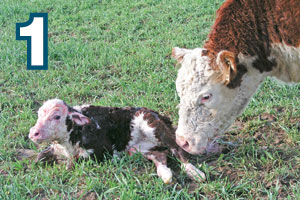 5. A dozen tips to lighten calving days
5. A dozen tips to lighten calving days
http://bit.ly/vjhR1q
Kindra Gordon gathered the most helpful advice for easier calving days, as featured in our February issue, by talking to producers in Kansas and South Dakota. Key tips included selecting genetics for calving ease, watching nutrition prior to calving, monitoring body condition, providing shelter, keeping pens clean, using nylon straps, use of a calf-hauler, keeping good records, being prepared for sickness and planning for next year.
PHOTO: A newborn Hereford calf at Sandhill Farms near Haviland, Kansas. Photo courtesy of Vera Schultz.
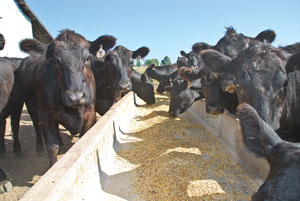 6. The Five Freedoms of Cattle
6. The Five Freedoms of Cattle
http://bit.ly/uKPSpB
Producers who have earned their spurs in the animal welfare business can take pride in those practices to keep animals safe. Texas A&M University beef specialist Ron Gill explained the key standards that define the philosophy of welfare management in “The Five Freedoms of Cattle.”
The five freedoms are:
Freedom from thirst, hunger and malnutrition – by ready access to fresh water and a diet to maintain full health and vigor.
Freedom from discomfort – by providing a suitable environment including shelter and a comfortable resting area.
Freedom from pain, injury and disease – by prevention or rapid diagnosis and treatment.
Freedom to express normal behavior – by providing sufficient space, proper facilities and company of the animals’ own kind.
Freedom from fear and distress – by ensuring conditions that avoid mental suffering.

Ron Gill
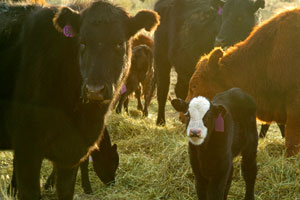 7. Cattleman blog: The struggle and success of A.I. calving
7. Cattleman blog: The struggle and success of A.I. calving
http://bit.ly/vDksZE
While studies repeatedly show a smaller percentage of beef producers use artificial insemination (A.I.) technology for breeding, this blog column from Idaho rancher Kim Brackett shared experiences on where to start.
Brackett and her husband started their new A.I. breeding program plan in 2010 and started synchro, bull selection and mass-breeding steps.
Once February rolled around the next year, calving was in full force for three weeks. Just as quickly as it started, it was over with a good-looking calf crop.
What advice would you give to a producer who’s unsure about using A.I. technology? Do you find it worth the expense and research?
First, get experienced help in setting up your A.I. protocol, such as A.I. technicians or university extension resources. Second, when artificially inseminating heifers, use proven bulls with higher accuracies to improve the success rate.
Third, if you choose to synchronize A.I., especially during the colder months, consider the size of your calving facilities.
Be prepared to handle a large number of calves in a short period of time. Over one-fourth of our heifers calved during a 24-hour period.
The expense and research involved may be daunting to producers considering A.I. technology for the first time.
However, when taking into account the potential improvement to the genetics of our cow herd and the fact that the calves out of our A.I. sires are of superior quality, we have found that using A.I. technology is well worth the cost and time.
—Kim Brackett
PHOTO:A cow-calf pair among the crop at the Brackett operation in early 2011. Photo courtesy of Kim Brackett.
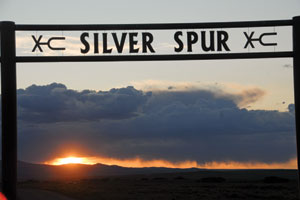 8. Adopting tradition and new ideas at Silver Spur Ranches
8. Adopting tradition and new ideas at Silver Spur Ranches
http://bit.ly/vv5kP7
Ranchers love tradition, especially when it’s found on a Western operation that does business from horseback.
Silver Spur Ranches own a name and legacy that utilizes top genetics and thrives in a backdrop covering three states.
Writer Robyn Scherer’s feature profile on Silver Spur and its origins dating back to the 1880s won over many readers by showing what a storied operation does to discover innovation.
PHOTO: A shot from one of the Silver Spur Ranches, in Encampment, Wyoming. Photo courtesy of Silver Spur Ranches.
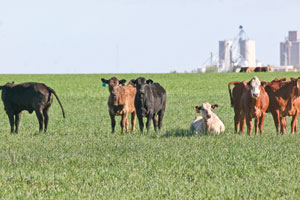 9. Major changes looming ahead for U.S. beef industry
9. Major changes looming ahead for U.S. beef industry
http://bit.ly/vMJkDn
While most producers already know the national beef herd has been in a steady pattern of decline, recognizing how that trend can be seen in costs and markets can be the constant challenge.
Colorado State University Extension beef specialist Jason Ahola spelled out in the July “State of the Industry” edition just how those trends will warrant a conscious effort from producers. Three key areas, he noted, to watch:
• Outrageous feed costs and market volatility
• Impending problems with mature cow size and feed efficiency
• Changing demand for calves based on weight, background
For years producers have pursued size and weight as the premium that paid the most. Are we seeing that pendulum swing elsewhere in 2012, due to feed and drought factors?
It seems that a future focus on optimization would be the best strategy. Since corn price appears to be sustaining itself in the $6 to $7 per bushel range, one can only assume that all feedstuffs will maintain their prices at about double pre-2007 levels.
Unfortunately, this new reality is not what the U.S. beef industry was built on – it was built on cheap feed, including hay under $100 per ton and corn at about $2.50 per bushel.
We’ve reached a point, five years into a run-up in feed prices, where cow/calf producers are reconciling decades of marketing and genetic selection decisions made based on cheap inputs with new realities of the U.S. beef industry.
Most of these past decisions (which emphasized sale weight) focused on maximizing outputs and generally ignored the amount of inputs required to produce them.
Moving forward, cow/calf operations will be challenged with nutritionally managing bigger cows (which are the result of long-term selection for calf growth and sale weight over the past 25 years) so that they can survive both harsh winters and dry summers on a limited amount of high-cost forage.
Cow/calf producers that strive for optimum production, including placing downward pressure on genetics for mature weight while maintaining calf growth – through the use of a multi-trait selection index – will be more likely to survive as elevated input prices and the risk of catastrophic drought continue.
Unfortunately, no such selection tool is available to most cattlemen today, since few bull buyers (or their breed associations) are providing one for their customers.

—Jason Ahola
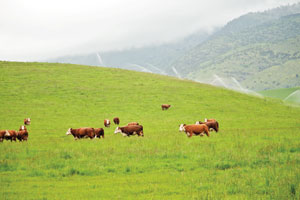 10. Grass-finished beef: Marketing the facts
10. Grass-finished beef: Marketing the facts
http://bit.ly/vItYcg
Today’s producers and beef consumers are routinely told how grass-finished beef has healthier nutrients than traditionally raised grain-finished beef.
But in this article by Cassie Payne, a ruminant nutritionist and Progressive Cattleman writer, those claims don’t stand up to careful analysis – grain-finished and grass-finished beef can offer healthy amounts of conjugated linoleic acid, and grass-finished beef has only minimal increases of Omega 3s.
How should producers decide if the appeal of grass-finished beef is high enough for their marketing process?
The appeal of grass-finished beef is typically greatest in areas where local farmers’ market attendance is high in addition to a strong cultural support for local establishments.
In published surveys, word of mouth is found to be the greatest marketing tool. Many producers do well with e-commerce sales, but first the reputation needs to be established locally.
Even if a retail contract cannot be obtained, the most successful producers of grass-finished beef have websites, business cards and a regular booth at a farmers market where cooked beef may be sampled. Having strong relationships with regular customers is a principal key to success.
—Cassie Payne
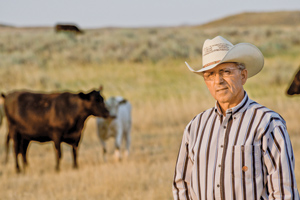 11. Minow herd the result of careful breeding, meticulous records
11. Minow herd the result of careful breeding, meticulous records
http://bit.ly/tqWRrh
Most cattle breeders know building a solid herd takes time and careful analysis of genetic performance. In a profile by Martha Mintz, Montana rancher Ben Minow proved how that kind of track record can sometimes unfold over a number of years.
The Minow herd’s line, which breeds Angus replacement heifers and Limousin-Angus-Hereford-cross commercial cows to Charolais bulls, has been built using A.I. and tighter calving windows. ![]()
PHOTO: Montana seedstock producer Ben Minow worked decades to breed the type of calves that showcase hybrid vigor of four breeds. Photo by Martha Mintz.
